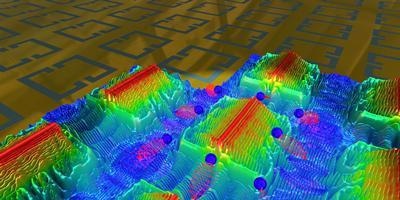A new threshold of light-matter coupling at the nanoscale has been achieved by physicists from the University of Southampton and ETH Zürich.
 Light focused by nano-antennas on a gold surface leaks out by generating propagating plasmons. Image Credit: University of Southampton.
Light focused by nano-antennas on a gold surface leaks out by generating propagating plasmons. Image Credit: University of Southampton.
The international study reported recently in the journal Nature Photonics integrated theoretical and experimental outcomes to determine the basic limitation of the potential to confine and utilize light.
The collaboration concentrated on photonic nano-antennas developed in ever-decreasing sizes on the top of a two-dimensional electron gas. Generally, the setup is utilized in laboratories across the globe to examine the impact of intense electromagnetic coupling. This leverages the antennas’ potential to trap and focus light close to electrons.
The fabrication of photonic resonators able to focus light in extremely small volumes is proving a key technology which is presently enabling advances in fields as different as material science, optoelectronics, chemistry, quantum technologies, and many others.”
Simone De Liberato, Professor, Director of the Quantum Theory and Technology Group, University of Southampton
“In particular, the focused light can be made to interact extremely strongly with matter, making electromagnetism non-perturbative. Light can then be used to modify the properties of the materials it interacts with, thus becoming a powerful tool for material science. Light can be effectively woven into novel materials,” added De Liberato.
Researchers found that light loses its ability to be restricted in the system below a critical dimension of the order of 250 nm in the sample under study. At the same time, the experiment started exciting propagating plasmons. This was the reason behind the waves of electrons traveling away from the resonator and shedding the photon’s energy.
The experiments carried out in the research group of Professors Jérôme Faist and Giacomo Scalari at ETH Zürich have offered outcomes that could not be explained with the advanced understanding of light-matter coupling. The physicists joined hands with Southampton’s School of Physics and Astronomy, where the scientists headed theoretical analysis. A novel theory with the ability to quantitatively reproduce the results was created.
Professor De Liberato hopes that the newly discovered limits could yet be surpassed by experiments conducted in the future. This paves the way for significant technological progress that hinges on ultra-confined electromagnetic fields.
Journal Reference:
Rajabali, S., et al. (2021) Polaritonic nonlocality in light-matter interaction. Nature Photonics. doi.org/10.1038/s41566-021-00854-3.